- Region
- Águilas
- Alhama de Murcia
- Jumilla
- Lorca
- Los Alcázares
- Mazarrón
- San Javier
-
ALL AREAS & TOWNS
- AREAS
- SOUTH WEST
- MAR MENOR
- MURCIA CITY & CENTRAL
- NORTH & NORTH WEST
- TOWNS
- Abanilla
- Abarán
- Aguilas
- Alamillo
- Alcantarilla
- Aledo
- Alhama de Murcia
- Archena
- Balsicas
- Blanca
- Bolnuevo
- Bullas
- Cañadas del Romero
- Cabo de Palos
- Calasparra
- Camping Bolnuevo
- Campo De Ricote
- Camposol
- Canada De La Lena
- Caravaca de la Cruz
- Cartagena
- Cehegin
- Ceuti
- Cieza
- Condado de Alhama
- Corvera
- Costa Cálida
- Cuevas De Almanzora
- Cuevas de Reyllo
- El Carmoli
- El Mojon
- El Molino (Puerto Lumbreras)
- El Pareton / Cantareros
- El Raso
- El Valle Golf Resort
- Fortuna
- Fuente Alamo
- Hacienda del Alamo Golf Resort
- Hacienda Riquelme Golf Resort
- Isla Plana
- Islas Menores & Mar de Cristal
- Jumilla
- La Azohia
- La Charca
- La Manga Club
- La Manga del Mar Menor
- La Pinilla
- La Puebla
- La Torre
- La Torre Golf Resort
- La Unión
- Las Palas
- Las Ramblas
- Las Ramblas Golf
- Las Torres de Cotillas
- Leiva
- Librilla
- Lo Pagan
- Lo Santiago
- Lorca
- Lorquí
- Los Alcázares
- Los Balcones
- Los Belones
- Los Canovas
- Los Nietos
- Los Perez (Tallante)
- Los Urrutias
- Los Ventorrillos
- Mar De Cristal
- Mar Menor
- Mar Menor Golf Resort
- Mazarrón
- Mazarrón Country Club
- Molina de Segura
- Moratalla
- Mula
- Murcia City
- Murcia Property
- Pareton
- Peraleja Golf Resort
- Perin
- Pilar de la Horadada
- Pinar de Campoverde
- Pinoso
- Playa Honda
- Playa Honda / Playa Paraíso
- Pliego
- Portmán
- Pozo Estrecho
- Puerto de Mazarrón
- Puerto Lumbreras
- Puntas De Calnegre
- Region of Murcia
- Ricote
- Roda Golf Resort
- Roldan
- Roldan and Lo Ferro
- San Javier
- San Pedro del Pinatar
- Santiago de la Ribera
- Sierra Espuña
- Sucina
- Tallante
- Terrazas de la Torre Golf Resort
- Torre Pacheco
- Totana
- What's On Weekly Bulletin
- Yecla


- EDITIONS:
 Spanish News Today
Spanish News Today
 Alicante Today
Alicante Today
 Andalucia Today
Andalucia Today
History of La Unión
La Unión, 2000 years of mining activity
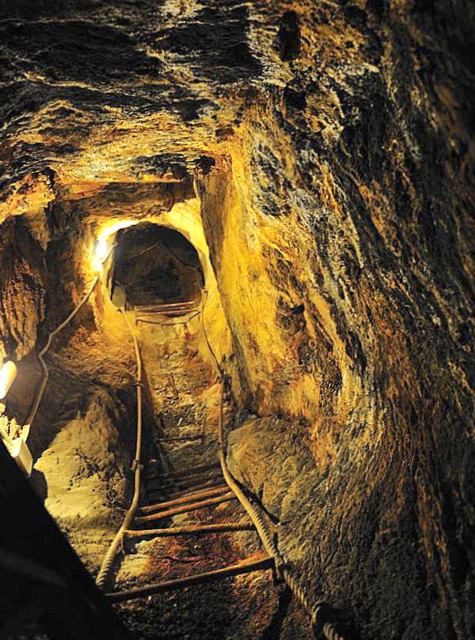 Prehistoric La Unión
Prehistoric La Unión
The only way to understand this landscape and what remains today is to understand the past, and there´s only one thing which dominates in La Unión and that´s man´s quest for mineral wealth.
The history of La Unión is irrevocably entwined with that of its mines, exploited by mankind since Prehistory.
Archaeological sites at Mina Balsa, Atalaya and Cabezo Agudo have all yielded evidence of early human habitation, the area chosen for settlement principally due to the resources to hand in the mountains and easy access to the sea via the bay of Portmán. Archaeological sites exist from the Paleolithic period (11,000 years ago) through the Neolithic and into the Bronze age, several sites showing evidence of fishing and hunting activity.
There was also certainly Neanderthal presence in the area demonstrated by the remains found in the Cabezo Gordo at Torre Pacheco, which is amongst the most important Neanderthal sites in the world.
As time moved on, and mankind learnt how to mine and smote metals, this area attracted Iberian populations, the area referred to by the Mastia, the tribe which occupied this area, as "Iluro". The Iberians traded extensively with the traders who worked the Mediterranean basin, namely the Greeks and Phoenicians, exchanging raw materials for finished goods, Greek ceramics regularly turning up on Iberian burial sites and a good selection can be found in the Archaeological Museum in Cartagena.
Cabezo Agudo (literally "pointed hill") is about half a mile from La Unión, and yielded remnants of walls and ceramics, square and rectangular rooms, residues and ashes from working with lead, silver and a little copper, various animal bones (mainly horses, boar, and various carnivores) and some fragments of coloured glass. Below these there are also relics here from the most primitive times of human settlement; mainly made from bone, stone and metal.
What is now called the Sierra Minera is an area filled with important mineral deposits, and as metal increased in importance, so did the area now known as La Unión.
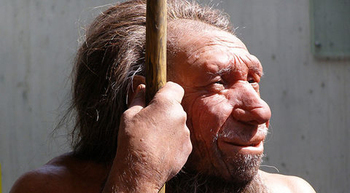 Mediterranean Civilisations in La Unión
Mediterranean Civilisations in La Unión
The Bay of Portmán attracted the ships of the Phoenicians to the locality. This great trading nation plied their trade along the Mediterranean basin and beyond, trading a vast range of products which ranged from raw mineral components, carried from as far afield as Cornwall in the UK, to oils, fine woods and luxury goods from Africa and modern day Lebanon, Syria and Israel.
They are known to have been most active in this area around 600 BC, with several wrecks dating from this period located off the Murcian coastline. Click here to read more about the Phoenicians in Murcia, Click Phoenicians in Murcia.
A Phoenician legend recounts how an inhabitant of Mastia named Aletes, discovered the silver mines of Cabezo Rajao and was revered as a god by his contemporaries, who built a temple to him on what is now the Cabezo de los Moros. According to the legend the temple was destroyed in the year 425. Although the Phoenicians were expert metallurgists, they did not undertake mining activities themselves, confining their interaction to trading raw materials for finished trade goods.
The excavations at Cabezo Agudo have also revealed some of these ceramic trade goods from Greek and Iberian cultures, as well as mining tools and residues from the treatment of metals, ceramics, weapons and urns which indicate relationships with the wine-making and olive oil regions of the Baetic and Tarragona areas.
The Carthaginians in La Unión
 The arrival of the Carthaginians in this area is visually (although a little poetically) portrayed in the Romans and Carthaginians festival which takes place every year in Cartagena and is one of the most colourful and exciting festivals in the Region,
The arrival of the Carthaginians in this area is visually (although a little poetically) portrayed in the Romans and Carthaginians festival which takes place every year in Cartagena and is one of the most colourful and exciting festivals in the Region,
It´s a long story, but basically Phoenician traders were driven from their original settlements in Lebanon and Syria, to inhabit settlements further down the African coast amidst fierce competition for trade routes along the Mediterranean basin. They founded a city, Carthage, on the North-African coast, from whence a population known as the Carthaginians emerged. Caught up in plans for Roman expansion, they were forced to fight with the ambitious Roman Empire for their trade routes,culminating in two episodes of the Punic wars, but the Romans drove them further down the coast and in 223BC they arrived in what is now Cartagena with an army, effectively carrying out a peaceful invasion of one of their former trading colonies.
During the period of Carthaginian domination, they exploited the natural resources of the mountains, the mines and esparto grass forming the basis of their economic activity economy for a large part of the time they dominated the area, using the silver mined in the Sierra Minera to fund the war against Rome.
A treaty permitted the two warring sides to live in some sort of peace until 217 BC when the famous General Hannibal, a Carthaginian living in Cartagena attacked Sagunto, breaking the treaty, then decided to attack Rome via the Alps with his army of elephants. In 210 BC the Romans exploited the weak defences left behind and invaded, taking the city of Cartagena and ultimately destroying Hannibal, and eliminating the Carthaginians as a definable culture.
The Romans in La Unión
The Romans ruthlessly exploited the mineral wealth of the area, "Portus Magnus" (nowadays Portmán) was 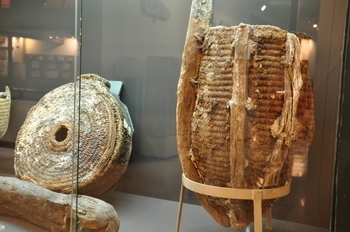
Excavations of Roman sites have been undertaken at Cabezo Rajao and La Atalaya, but unfortunately both sites had been heavily plundered. Roman coins have been found at both sites, as well as pieces from other parts of the peninsula and the north of Africa and there are several major Roman sites around the area including the Roman Villa at Portmán and the Cabezo del Pino.
It is believed that the exploitation of the mines lasted until the reign of the Emperor Augustus when, as in the rest of Roman Spain, mining reached its high point. At this time there were between 25,000 and 40,000 people working in the mines here, depending on which historian is consulted, 35,000 being a widely accepted average.
The minerals here were particularly rich, yielding 3 kilos of silver per 1000 kilos of lead, and helped to fund the total destruction of the Carthaginians and dominance of Rome for several hundred years.
With the decline in the Roman Empire in the fifth century AD, mining virtually stopped.
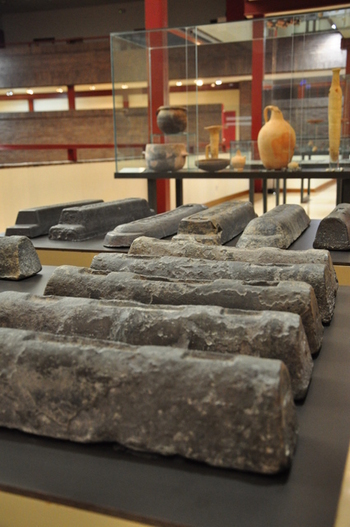
There is also an interesting archaeological site at Cabezo del Pino on the La Unión to Portmán road which is currently under excavation. This is a site which was used to grind, wash and prepare the galena for smelting and is the first of its kind to be excavated in Spain. Click Cabezo del Pino for full report and photos.
The Barbarian Invasions
Following the decline of the Roman Empire, the area was subject to continuous invasions by Barbarians, Byzantines and Moors, as well as Berber pirates.
The area of La Unión was practically abandoned at this time, and mining almost totally ceased, so only sporadic evidence exists of this and other towns, one instance being from the year 425 when Gunderic, King of the Vandals, rampaged through the streets of Cartagena and surrounding settlements.
Islam and the Reconquista
Under Moorish occupation there was little population in the area of La Unión: the Moors did exploit some mines in Andalucía, but werent interested in La Unión.
However, the Reconquist and subsequent Christian occupation changed that, and in the 13th century official mining activity recommenced in Murcia. Alfonso X ("The Wise") reserved the mines of La Unión for the Crown, although they could effectively be leased to private enterprise in exchange for the payment of taxes. In 1387 a law was passed which allowed mining exploitation, and the Catholic Monarchs passed ordinances rewarding the miners.
Little is known about the scale of activity or the actual settlements in this period.
The Interests of the Crown in the Mines of Cartagena
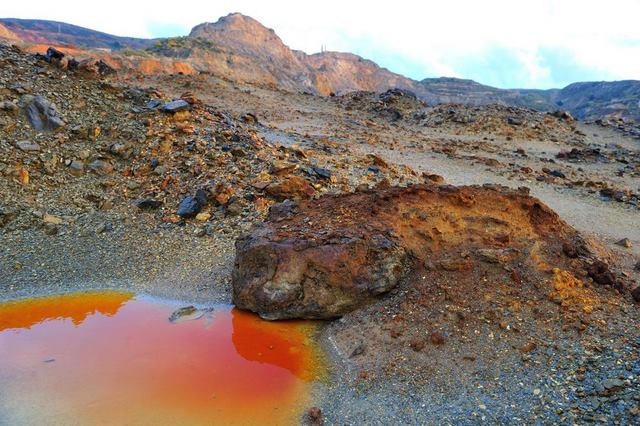 In 1527, Emperor Carlos V licensed Francisco de los Cobos to carry out activities of mining exploitation within the boundaries of Cartagena, which included La Unión. Later, in 1587, Felipe II gave permission to Felipe del Río to benefit from silver and lead in "Sancti Espíritu", the name of the hill where the town of La Unión now stands.
In 1527, Emperor Carlos V licensed Francisco de los Cobos to carry out activities of mining exploitation within the boundaries of Cartagena, which included La Unión. Later, in 1587, Felipe II gave permission to Felipe del Río to benefit from silver and lead in "Sancti Espíritu", the name of the hill where the town of La Unión now stands.
There was undoubtedly an element of fantasy among the mining fraternity regarding the possible rewards to be reaped from the mines. This was certainly the case when Felipe III issued an authorization to exploit one of the mines at Portmán, where mention is made of "stones of black and red amethyst, and sparkling sapphires". Various licences for mining in Cartagena were also issued during the reign of Carlos III.
At this time , Alumbre was an important mineral, used for setting the dye in cloth, as a disinfectant and a medicinal product. The settlement of Alumbre is named for this mineral which was mined extensively in this period and which can still be purchased from the Parque Minero reception.
1840: Contemporary Mining Begins
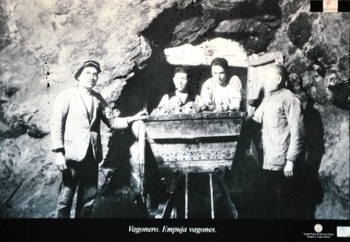 The resurrection of the mining industry in La Unión began in 1840, as an intrinsic part of the general upsurge in Spanish mining linked to the industrial revolution, and the area became something of a Spanish equivalent of California due to the richness of its mineral resources.
The resurrection of the mining industry in La Unión began in 1840, as an intrinsic part of the general upsurge in Spanish mining linked to the industrial revolution, and the area became something of a Spanish equivalent of California due to the richness of its mineral resources.
One of the consequences of this rush to the mines was, of course, a significant increase in the population of Murcia, thanks mainly to immigrants to the area from Andalucía. In La Unión many of the new arrivals were from Almería, although there was also a significant number of entrepreneurs looking to make their fortunes from the labours of others.
The Founding of the Town of La Unión
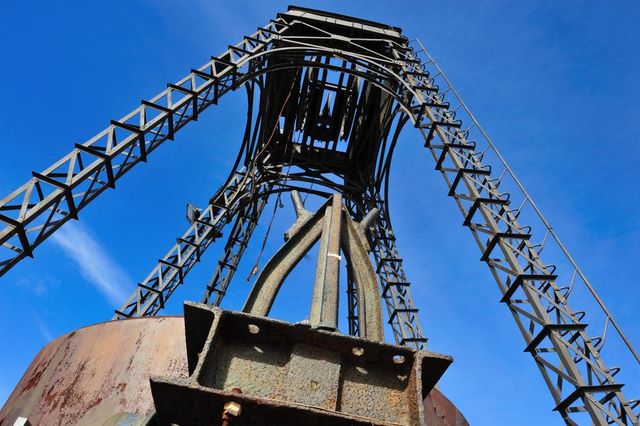 The rise in the populations of El Garbanzal, Herrerías, Portmán and Roche had important consequences, not only in economic terms but also political: the time was right to move towards administrative and judicial independence. Previously La Unión had always been subsumed into Cartagena, but now the locals requested independence and their own Town Hall. This was achieved on 1st January, 1860, when A Royal Decree signed by Isabel II named the township of "Villa de El Garbanzal", the name which originally covered the group of settlements included.
The rise in the populations of El Garbanzal, Herrerías, Portmán and Roche had important consequences, not only in economic terms but also political: the time was right to move towards administrative and judicial independence. Previously La Unión had always been subsumed into Cartagena, but now the locals requested independence and their own Town Hall. This was achieved on 1st January, 1860, when A Royal Decree signed by Isabel II named the township of "Villa de El Garbanzal", the name which originally covered the group of settlements included.
In 1868 the name was changed to "Villa de La Unión", but in fact the union had been very difficult to achieve, with conflicts arising among the different localities. Herrerías wanted to become a municipality on its own, but El Garbanzal was against the idea, and it took General Prims intervention in 1868 to ensure that agreement was reached.
Although the mines yielded substantial profits at times, there were also crises within the sector. These brought about recessions in the town as a whole, since almost all the population was directly or indirectly dependent on the mines. The profits, then, were high at times, but always fragile, and heavily dependent on fluctuations in the London metal trading market.
The Golden Age of La Unión
A new age of splendour took place at the end of the 19th century and the beginning of the 20th. This was the towns moment of glory, and brought about not only an increase in the towns population but also important urban reforms which lent it a certain prestige. Examples include the building of the Mercado Público, the Casa del Piñón and the Iglesia del Rosario.
This time of great expectations also contributed to a higher level of general wealth throughout the area. Thousands of workers arrived from all over Murcia and Andalucía, bringing with them their families and possessions. It was said at this time that rich men "lit their cigars using 100-peseta notes."
 Of course, whilst the mineowners enjoyed the profits to be had from owning the major mining exploitations, it was hard, dangerous work for those employed in the gruelling labour of mining the minerals. There was no social security, hours were long and demanding, and working conditions were appalling. Miners were exposed to incurable diseases which cut life expectancy, and salaries failed to compensate for their efforts and the danger to which they were exposed on a daily basis. Accidents and injuries were frequent, and the Hospital de Caridad in Portmán was founded to respond to the problem.
Of course, whilst the mineowners enjoyed the profits to be had from owning the major mining exploitations, it was hard, dangerous work for those employed in the gruelling labour of mining the minerals. There was no social security, hours were long and demanding, and working conditions were appalling. Miners were exposed to incurable diseases which cut life expectancy, and salaries failed to compensate for their efforts and the danger to which they were exposed on a daily basis. Accidents and injuries were frequent, and the Hospital de Caridad in Portmán was founded to respond to the problem.
In the end, most of the private money made in the mines of La Unión left the town, much of it settling in Cartagena. Some of it went, for example, towards the construction of the sumptuous Palacio de Aguirre (now the MURAM, Click MURAM, Cartagena) and the Casa Cervantes, also in Cartagena, now the seat of the CAM.
Mining Crisis
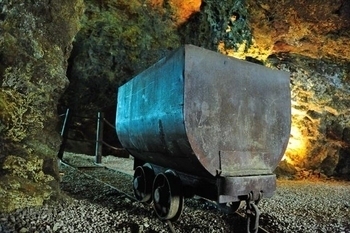 The mining industry entered an inexorable decline at the start of the 20th century, especially following the First World War. La Unión depended to a large extent on the health of the national mining industry, and the years during and immediately after the Civil War were hard, bringing hunger and misery to the town.
The mining industry entered an inexorable decline at the start of the 20th century, especially following the First World War. La Unión depended to a large extent on the health of the national mining industry, and the years during and immediately after the Civil War were hard, bringing hunger and misery to the town.
Recovery arrived in the 1950s, with the introduction of more modern mining methods, re-opening previously abandoned mines and making use of the discarded material from previous activity. The multinational Peñarroya monopolized mining in the Sierra Minera from 1957 to 1985, using advanced production methods, namely open cast mining, ripping open vast pits which scar the landscape today, and pouring millions of tons of waste material into the bay of Portman, causing one of the Mediterranean´s worst ever ecological disasters. However, in 1988, with the mines in irreversible decline, the company changed hands and the mines were taken over by Portmán Golf, who intended to combine mining with tourism activities in Portmán Bay.
In 1991, though, after two millennia of mining activity, the mines were shut down for the last time. Production was no longer economically viable due to the exhaustion of reserves and lower prices on the international metal markets, and the heavy pollution of Portmán Bay was causing alarm at all levels of society.
The city had become a dormitory town for Cartagena during the 1980s, and when the mines folded it became a matter of urgency to find a new economic model for La Unión. The lack of immediate alternatives meant the most severe crisis ever suffered by the town.
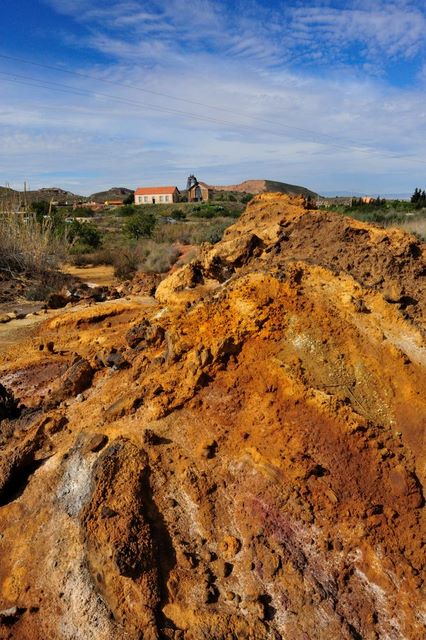 The Remains of the Mining Past
The Remains of the Mining Past
The essence of the mines still remains in the municipality. Little is left of the old traditions of the mining society, but what there is includes the music, which strictly speaking doesnt have its roots in the locality, but is ingrained in the traditions which have grown up over the years. The style is clearly derived from the flamenco traditions of the immigrants from Almería, Córdoba and Granada, and is mixed with traces of Murcian culture.
The result is already an essential part of Murcias folklore, a mixture of mining, flamenco and Cartagena. Together with the "trovo" (a kind of musical poem) and the "saeta" (religious music associated with Semana Santa), the "Cante de las Minas" is part of the very soul of La Unión.
Esteban Bernal created a 5-metre-high sculpture which is now in the Plaza Joaquín Costa, dedicated to "the generations who are yet to come, that they may remember their forefathers, who, through labour and sacrifice, lifted this corner of Murcia to the highest heights".
There is a visual reminder of days gone by in the landscape of the Sierra Minera itself, but the mines and related industry have left their mark on the landscape, sometimes for the worse in the case of the pollution of Portmán, and therein lies the heritage of the town.
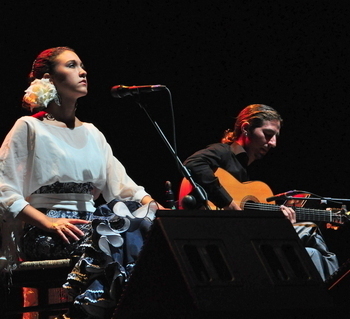
The focus of this is the Cante de las Minas Flamenco Festival, held annually, one of the most prestigious flamenco events in the world, which annually attracts an international audience and the greats of the world of flamenco.
This is allied with a new Flamenco school and the impressive Parque Minero, with further projects underway to consolidate the future of La Unión in its past.
article_detail
Cartagena
El Carmoli
Islas Menores and Mar de Cristal
La Manga Club
La Manga del Mar Menor
La Puebla
La Torre Golf Resort
La Union
Los Alcazares
Los Belones
Los Nietos
Los Urrutias
Mar Menor Golf Resort
Pilar de la Horadada
Playa Honda / Playa Paraiso
Portman
Roldan and Lo Ferro
San Javier
San Pedro del Pinatar
Santa Rosalia Lake and Life resort
Terrazas de la Torre Golf Resort
Torre Pacheco
Aledo
Alhama de Murcia
Bolnuevo
Camposol
Condado de Alhama
Fuente Alamo
Hacienda del Alamo Golf Resort
Lorca
Mazarron
Puerto de Mazarron
Puerto Lumbreras
Sierra Espuna
Totana
Abaran
Alcantarilla
Archena
Blanca
Corvera
El Valle Golf Resort
Hacienda Riquelme Golf Resort
Lorqui
Molina de Segura
Mosa Trajectum
Murcia City
Peraleja Golf Resort
Ricote
Sucina
Condado de Alhama
El Valle Golf Resort
Hacienda del Alamo Golf Resort
Hacienda Riquelme Golf Resort
Islas Menores and Mar de Cristal
La Manga Club
La Torre Golf Resort
Mar Menor Golf Resort
Mazarron Country Club
Mosa Trajectum
Peraleja Golf Resort
Santa Rosalia Lake and Life resort
Terrazas de la Torre Golf Resort
La Zenia
Lomas de Cabo Roig

CAMPOSOL TODAY Whats OnCartagena SpainCoronavirusCorvera Airport MurciaMurcia Gota Fria 2019Murcia property news generic threadWeekly Bulletin



